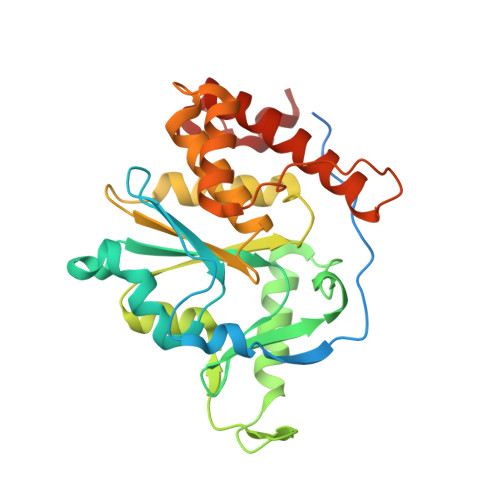Structural and biochemical analysis of a unique phosphatase from Bdellovibrio bacteriovorus reveals its structural and functional relationship with the protein tyrosine phosphatase class of phytase.
Gruninger, R.J., Thibault, J., Capeness, M.J., Till, R., Mosimann, S.C., Sockett, R.E., Selinger, B.L., Lovering, A.L.(2014) PLoS One 9: e94403-e94403
- PubMed: 24718691
- DOI: https://doi.org/10.1371/journal.pone.0094403
- Primary Citation of Related Structures:
4NX8 - PubMed Abstract:
Bdellovibrio bacteriovorus is an unusual δ-proteobacterium that invades and preys on other Gram-negative bacteria and is of potential interest as a whole cell therapeutic against pathogens of man, animals and crops. PTPs (protein tyrosine phosphatases) are an important class of enzyme involved in desphosphorylating a variety of substrates, often with implications in cell signaling. The B. bacteriovorus open reading frame Bd1204 is predicted to encode a PTP of unknown function. Bd1204 is both structurally and mechanistically related to the PTP-like phytase (PTPLP) class of enzymes and possesses a number of unique properties not observed in any other PTPLPs characterized to date. Bd1204 does not display catalytic activity against some common protein tyrosine phosphatase substrates but is highly specific for hydrolysis of phosphomonoester bonds of inositol hexakisphosphate. The structure reveals that Bd1204 has the smallest and least electropositive active site of all characterized PTPLPs to date yet possesses a unique substrate specificity characterized by a strict preference for inositol hexakisphosphate. These two active site features are believed to be the most significant contributors to the specificity of phytate degrading enzymes. We speculate that Bd1204 may be involved in phosphate acquisition outside of prey.
- Lethbridge Research Center, Agriculture & Agri-Foods Canada, Lethbridge, AB, Canada.
Organizational Affiliation:


















